A visually appealing Android app design is significant for creating a user-centric interface that enhances the overall experience of the users.
Updated 18 March 2024

Sr. UI/UX Designer at Appventurez
Designing an Android app is arguably the most significant part of app development as it plays a crucial role in attracting users by providing a coherent and intuitive experience. Understanding the role of UI/UX design has also become paramount for businesses that are looking to expand and make a difference in the market.
To enhance the user experience, it is important that the Android app design is adaptable and can also be used for different mobile devices. The process of availing UI design services for an Android app entails different steps including the color used in the app design, layout, color themes, elements, and tools that will be integrated into the app by an Android app development company.
Notably, at the core of the Android app development process lies the creation of a user-centric design that guides them through a seamless and intuitive journey. In this blog, we will further discuss the process of app design for an Android app and will also explore the essential tools, principles, and guidelines that need to be followed during the design process.
The Android design hub is a comprehensive resource that is designed to empower designers and developers to create stunning and user-friendly interfaces for Android apps. It is about sharing takeaways, examples, do’s and don’ts, starter Figma kits, UI samples, and inspiring galleries.
Android UI design hub is significant for the mobile app design process and in making the app successful. It is a comprehensive resource for mastering the art of designing and implementing UI on a diverse range of devices, from smartphones and tablets to foldable to wearables and TVs.
The following components can be found in the Android UI design hub.
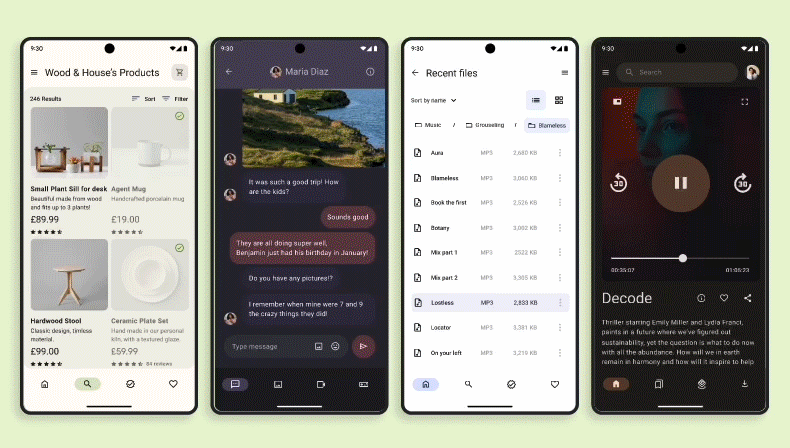
Under the design hub, you can gain access to a library tailored for each form factor, including guidance, design templates, and sample projects. With these resources at your fingertips, you can create exceptional UI experiences for every device category.
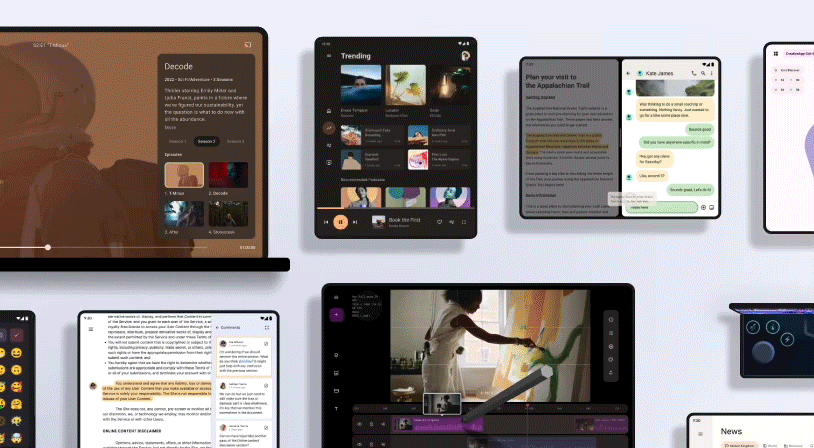
With the Android UI design hub, you can explore the collection of Android app designs for a variety of popular categories of apps such as social, health &fitness, shopping, and more. You can craft an advanced app by discovering the design patterns that also help in tackling common design challenges.
By going through the Android design guidelines, you can learn how to implement high-quality Android designs and understand the app layout with Android system bars, navigation modes, theming, and more. The comprehensive documentation also ensures that the app’s design adheres to the highest standards.

With the help of an Android UI design hub, you can equip yourself with an extensive selection of design tools, templates, and resources that are particularly tailored for building an Android app. It will also help you streamline your workflow and bring your Android design patterns idea to life more efficiently.
Mobile UX design is the way an application is created to provide users with the best possible user experience. Designers, while crafting the Android app design, are tasked with crafting products that are not only enjoyable to use but can also deliver a pertinent and impactful experience for the users.
In the realm of mobile UX design services, it is also essential to take into account the complete customer journey, which includes all aspects of interaction, content, and even sound design.
UX design plays a significant role in Android app design as it helps take focus beyond mere visual aesthetics and work towards providing a seamless experience to the users while using the Android app.
One of the prominent examples of UX design that creates a positive experience for users is Uber. A ride-sharing service that facilitates a seamless experience for its users by providing clear navigation options, including the use of GPS and a list of a few recent destinations in large, easy-to-read typography.
There are also clearly labeled buttons to switch from Uber to Uber Eats, as per the user’s convenience.
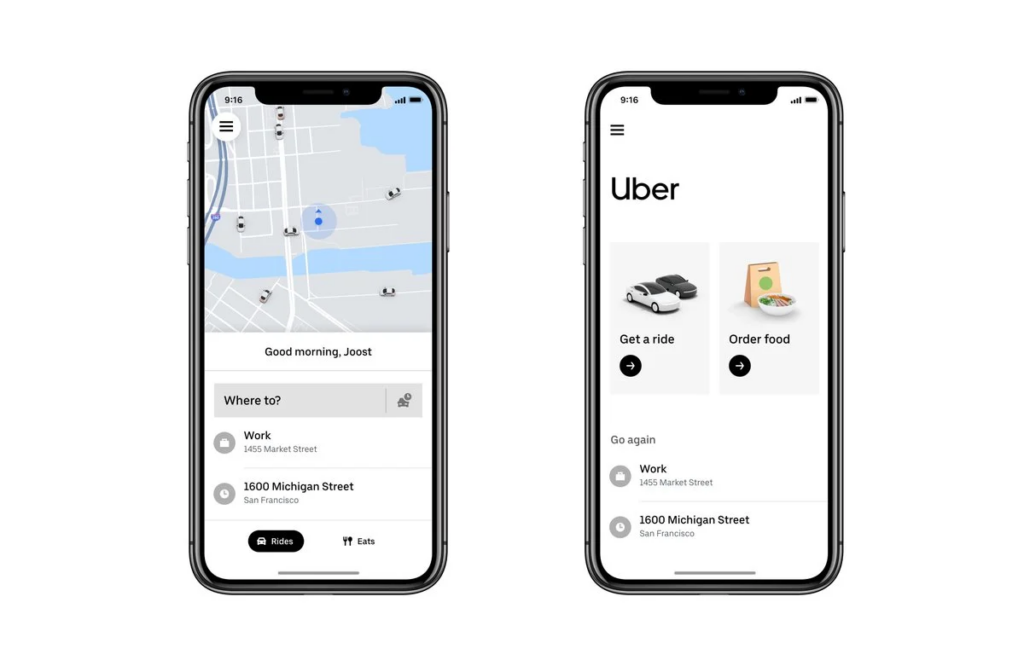
Source : Upwork
Before formulating the design strategy for an Android app, it is significant to identify the device for which you will be designing an intuitive UI/UX.
While designing modern Android apps, it is important to note that the app meets your users’ needs, whether they are playing on the phone, reading on their tablet, watching TV, or glancing at their wrist.
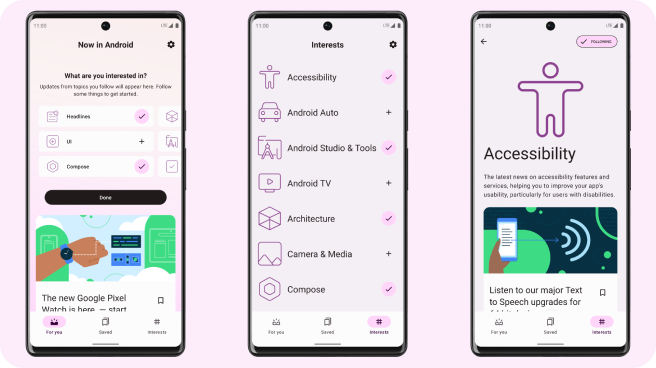
For a mobile app, you can create a beautiful and usable modern app design by using Android themes, components, and UI patterns. During the Android app design process for mobile, it is important to identify the layout and content for the mobile app, visual design, interaction patterns, and different styles including reusable, interactive, and UI building blocks.

For large screens, including desktops, laptops, and tabs, you can create an immersive and engaging user experience with layouts that resize and reconfigure to optimize the presentation, interactivity, and usability. Components such as navigation rail and drawer components provide out-of-the-way navigation for the UI convenience and control.

While designing an Android app for wearOS, adopt advanced material styles like color, motion, typography, and iconography. The features while designing an app for a smartwatch entail the facilitation of notifications to help the users get things done and stay updated.
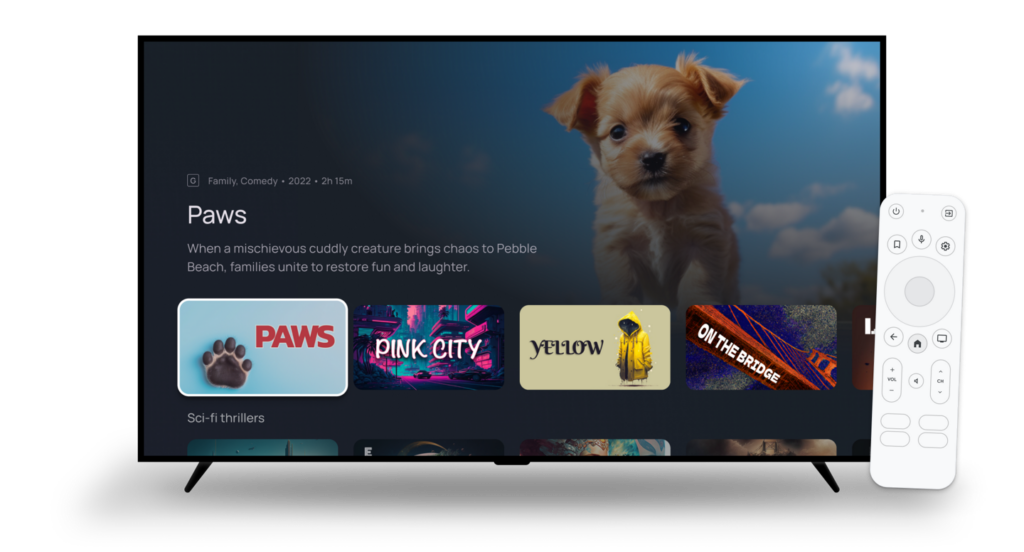
While designing an Android app for TV, the few prominent points that should be kept in mind is how the content should be structured within a view. The integration of advanced components and patterns for a TV app ensures the optimal user experience for the TV apps while maintaining consistency and enhancing engagement.
It is important to select the best Android app design tools for designing an intuitive app that ensures user engagement and provides a seamless experience. Check the best tools mentioned below that you can use for the UI process on Android.
It is an easy-to-use Android UI design software that makes the designing process more efficient and simple. It also simplifies the main features that are used in Illustrator and Photoshop and is designed specifically for UI/UX design.
It is an online tool that is easy to use and convenient even for those who have never engaged in the design process before. Wondershare Mockitt allows prototyping for a wide range of platforms, further making it possible for you to customize the device you need to design.
It is one of the most preferred Android app design tools used by designers in the current times. Figma has several functions and features that make the designing process seamless and fast.
This design tool also lets the designers collaborate, which means that everyone who is involved in the Android studio UI design can comment, edit, and provide feedback. Notably, this collaboration feature is available in both the prototyping and design modes.
It is another Android UI design tool that makes it easy to design fast with real collaboration. Zeplin aims to bring different teams and mindsets together and provide rich features that make it easy and efficient to design an Android app. Zeplin also lets the designers export designs from most of the other tools including including Sketch, Adobe Photoshop, Figma, and AdobeXD with less help from the plugins.
By creating an impressive UI/UX design, businesses can provide their users with a seamless experience that not only helps them meet their needs but also exceeds their expectations. The points below further explain the various benefits of an intuitive UI/UX design in the Android app.
An impressive Android app design helps in influencing the user’s behavior and facilitates an increased conversion rate.
By optimizing the user flow, businesses can guide them toward desired actions, such as making purchases, signing up for the services, or subscribing to the premium features. A positive user experience also helps to instill trust and confidence in the users, further increasing their willingness to engage with the app and make transactions.
Customer loyalty is significant to sustain success in the app market and a key driver of customer loyalty is a positive user experience. When a user finds an app that consistently meets their needs and offers an enjoyable experience, they are more likely to remain loyal and even recommend the app to their acquaintances.
UI/UX design is an excellent avenue for setting your Android app apart from its competitors. When users are faced with multiple app options that offer similar features, they often turn to design as a deciding factor. By investing in a well-designed and user-friendly interface of an app, you can create a unique brand identity for an app and establish a competitive edge.
By incorporating user-centered design principles, early in the Android app design process you can identify and address usability issues, design flaws, and user pain points before they become a costly problem in the future.
By prioritizing UI/UX design services, you can also foster strong relationships with the users further enhancing customer retention rates and maximizing the lifetime value of each customer.
Before you decide to start working on the design process of an Android app, it is important to identify certain factors that will influence the app design and will facilitate the users in experiencing an impressive User interface.
Everything that a business does revolves around its users and their growing preferences. Notably, according to the reports, approximately 62 thousand Android mobile apps were released through the Google Play Store in November 2023, showcasing the widespread popularity of Android apps among users all over the world.
Before working on the UI/UX of the Android app design, it is important to identify your users and what elements in the design will make the navigation of an app easier for them. It is also important to understand whether your design choices are improving user experience when they visit your app.
Our screens are made up of a bunch of reusable parts, otherwise known as the UI/UX elements. To design an Android app, the goal is not to be inventive with every instance, but rather to keep these elements consistent. For example, if the primary buttons are blue and rounded, they should always be the same, no matter where they are used.
When designing an Android app, it is important to consider the wider brand. If the Android app that you are creating is a part of the family of products, you will need to adhere to the brand colors, logo as well as the typography of the brand.
Hierarchy in the Android interface creates a visual order that makes content easy to understand and navigate. It is important to use different visual design elements, like color, size, and typography to help us generate hierarchy on a screen, making it easy for the user to make his or her way around the app.
During the Android app design, it is important to align with the native UI elements and platform-specific components as much as possible. When doing so, it is important to analyze how each platform recommends color, type, and other visual design elements.
Before diving into the process of designing an Android app, it is important to familiarize yourself with how much it will cost. There is no doubt that user interface (UI) and user experience (UX) play a vital role in the Android app development process, further impacting the Android app development cost.
A well-designed Android app not only enhances user satisfaction but also contributes to higher engagement. Additionally, understanding the complexity of the design requirements, including custom graphics, and interactive elements, and balancing aesthetic appeal with functionality is key to optimizing the Android app development-related process.
Let’s understand the Android design cost breakdown from the table below:
| Design Aspect | Cost Range |
|---|---|
| Initial Design and Conceptualization | $2,000-$10,000 |
| UX Design | $5,000-$20,000 |
| UI Design | $10,000-$30,000 |
| Adaptability and Responsive Design | $3,000-$8,000 |
| Custom Animations and Graphics | $2,000-$10,000 |
| User Testing & Iterations | $5,000- $15,000 |
| Integration with Third Party Services and APIs | $4,000-$10,0000 |
| Compliance and Accessibility | $3,000-$8,000 |
Here is a step-by-step process of crafting an Android app design that will enhance user experience and accelerate the app’s performance.
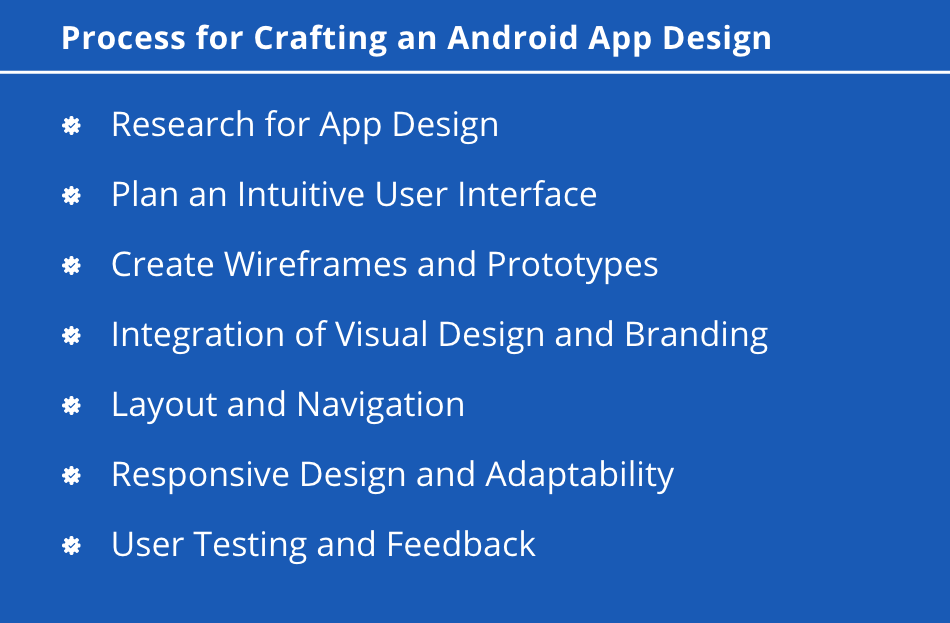
Get started by researching other mobile apps, and look at as many examples as possible. It will provide you with an insight into the challenges that you might face while developing Android app design. The research for an app design can be conducted in two parts:
The important thing is to figure out what your target audience wants. The easiest way to measure customer expectations is to visit the app store and look for testimonials and user reviews.
Once you go through it, you will understand the kind of design standards and performance parameters the app must have to succeed. You will also be able to get an idea of the features that the users like the most, and the ones that they didn’t appreciate much.
Competitor research means finding out what the competition is up to, particularly the UI/UX features that they incorporate into their apps. However, competitor analysis must always be viewed as an ongoing and never-ending process. You must keep yourself updated with the latest mobile app design trends to stay ahead of your competitors in the market.
An effective UI interface starts with cautious planning. This stage entails defining the objectives and goals of your Android app, finding information about its target audience, and figuring out the compatibility and functionalities it will provide.
By defining your app’s purpose and target market, you will be able to make knowledgeable design selections that align with the consumers’ wishes. Under this Android app design process, you can sketch out a rough layout of the displays and display screen flow to visualize the users’ journey.
Wireframing is fundamental in mobile UI design services because it permits you to outline your app’s interface. It presents a visual presentation of the structure and layout of your app, displaying the placement of key factors and interactions. You can start by portraying low-constancy wireframes that outline the app’s essential structure and functionality.
Once the wireframe design services are finalized, intuitively create prototypes by utilizing equipment such as AdobeXD or Figma to stimulate the user experience and gather comments from partners and potential users.
Visual design performs an important function in Android app design in making your app visually appealing and consistent, together with your brand identity.
The process involves integrating color, font, graphics, and other visible aspects to produce an aesthetically pleasing interface. Notably, a unified and memorable user interface by an Android app designer is made possible by consistent graphic elements and branding, which strengthens your brand recognition.
When creating the layout of an Android app UI design, your goal should be to build a well-organized and intuitive structure that allows the consumers to navigate the app easily. For Android app user interface design, the layout of the app should be visually appealing, easy to recognize, and consistent throughout the app.
You should also ensure that the navigation is clear and intuitive and provide the users with smooth and easy access to the app’s features and content. An organized and logical layout helps enhance the user experience and encourages them to collaborate with your app.
Responsive design in the Android app design process ensures that your app operates efficiently throughout the different display screen sizes, from small smartphones to large tablets. While designing an Android app, you should implement responsive layout ideas, including fluid layouts, scalable elements, and adaptive content to ensure a consistent and standard user experience on all devices.
User interface design is an iterative design process that flourishes on the development and user feedback. It is important to involve users during the design process to gain valuable insights regarding the navigation and layout of the app.
It is also crucial to conduct usability testing to validate your design, identify pain points, and figure out the areas that require development. By actively taking notes of the users, you will be able to create a consumer interface that resonates with your audience and provides an incredible user experience.
The key principles that you should keep in mind while designing an intuitive Android app are:
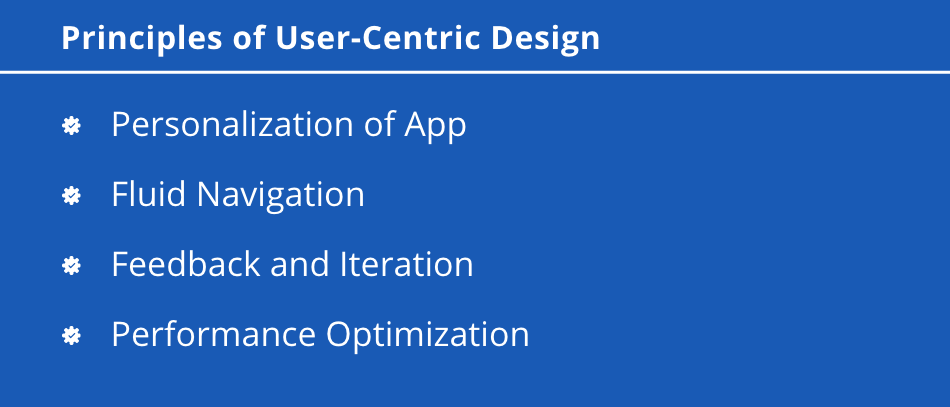
One of the most significant elements of designing a user-centric Android app is fluid navigation. Android app design with seamless navigation allows users to navigate the application interface seamlessly without unnecessary complexity.
Personalization of an Android app tailored to individual user preferences provides a more relevant and engaging experience. By incorporating features such as user-specific dashboards, and adaptive content recommendations, the Android app becomes more dynamic and personalized, further fostering a stronger connection between the app and the user.
In today’s evolving landscape of digital experiences, users expect a responsive and efficient application that responds promptly to user interactions and operates efficiently. Regularly monitoring and analyzing the performance ensures that the app remains a valuable asset in the fast-paced realm of enterprise operations.
Feedback and regular iteration create a continuous improvement loop further ensuring that the app design services evolve in response to the changing business dynamics and user expectations. Gathering feedback through surveys, reviews, and usability testing and fostering improvements foster a dynamic and user-centric app design and development process.
The following tips for Android app design will help you build a user-friendly UI that will enhance user experience.
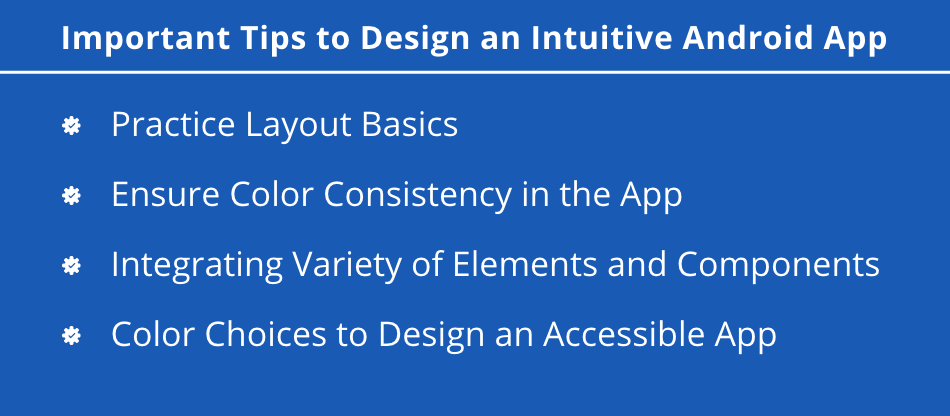
Sticking to a palette of colors through the Android app design is a must. It helps in relating colors to the action, for example, using pink for each of your buttons notes users what to expect when they see this color. It also makes the design look more consistent when there is a set color scheme used throughout.
For an Android app design, there are three clear design areas: the status bar at the top, the navigation bar at the bottom, and the body region that sits between the two. As the system bars are the top layer of your app design, the body region needs to carry on underneath them.
For example, when a user scrolls through an article, the words would disappear underneath the top and bottom bars. This makes sure that the users can interact successfully with your design while offering you creative freedom within the body region.
Color choices are not only important for aesthetic purposes, but they help in creating accessible designs too. To design Android app UI, it is important to note that the selected colors should not look identical on one device compared to another device. The hues and tons that you opt for Android app design may be slightly lighter or darker, so factor this in to optimize your app design for accessibility.
To make an Android app more advanced and user-friendly, you can make use of a different Android UI design tool, elements, and components at your disposal. Use action elements such as buttons as CTAs to get users to complete an action like signing up. You can also use communication elements such as progress bars to offer helpful information to the users.
In the current landscape where mobile apps are playing a crucial role in altering the growth of businesses, crafting an intuitive design for an Android mobile app ensures success as well as increased user experience. Designing an impressive app requires elements and tools that make the app more approachable and easy to use for the target audience of the app.
At Appventurez, our designers hold expertise in crafting an intuitive and seamless UI that will help you achieve business goals while providing what your user requires. Our team understands that embracing the key principles of user-centric design is not just a choice but also a strategic imperative that fosters an environment where technology is an enabler.
For instance, our expert designers provided their expertise in designing Holcim’s Clickit app by integrating an advanced set of UI/UX solutions to enhance the overall user experience.
Our goal is to prioritize the end user at every stage of user-centric design and development, varying from user research and understanding to performance optimization and designing an app that resonates, empowers, and elevates.
Q. What is UI and UX in Android?
In the world of Android app development, creating a seamless and intuitive user interface (UI), combined with a delightful user experience (UX) is extremely important. A well-crafted UI and UX can be a key to the success of an app, further ensuring user engagement and satisfaction.
Q. How to create a UI design for Android?
To create a UI design for an Android app, you can follow the mentioned process- download Android Studio from your browser, install Android Studio, open Android Studio, create a new project select the project type, give it a name of your choice, click on the resources folder, click on the layout folder and begin to design your UI.
Q. What are the design criteria for an Android application?
A few of the criteria that should be considered before designing an Android application are the overall, app structure, gestures UX which allows the users to interact with your app by manipulating the screen objects you provide, and navigation UX which is an essential component of the overall user experience.
Q. What are the elements of a good mobile app design?
A well-designed app should have high-quality images, fonts, colors, and graphics to convey information and create an appealing visual experience. The choice of the visuals should align with the app’s purpose and the target audience.


Elevate your journey and empower your choices with our insightful guidance.

Sr. UI/UX Designer at Appventurez
Durgesh Pal Singh specializes in translating complex ideas into elegant and user-friendly designs. With 7+ years of experience, he believes in the power of iterative design processes, allowing him to refine his work based on real-world user interactions. By bringing unique perspectives to his designs, Durgesh creates a meaningful impact on the way users interact with digital products.
You’re just one step away from turning your idea into a global product.
Everything begins with a simple conversation.